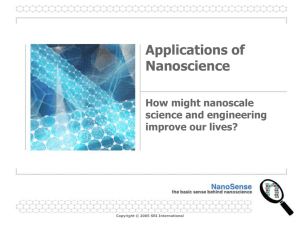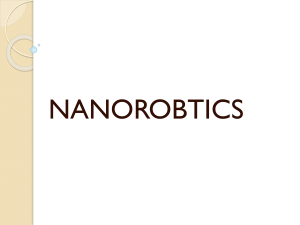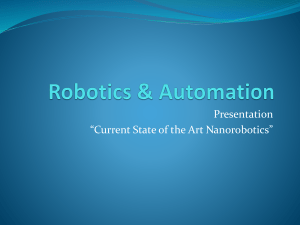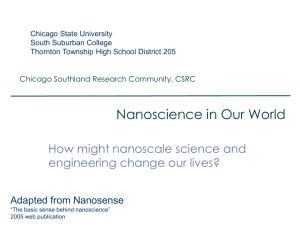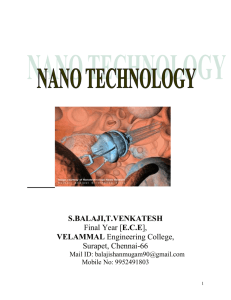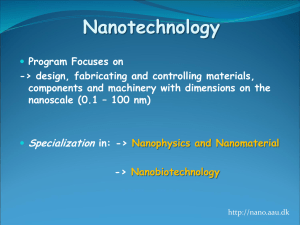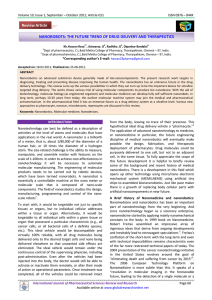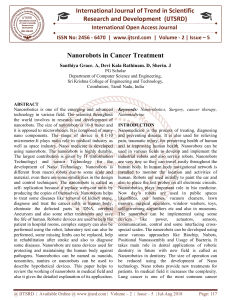PAPER PRESENTATION.DOC - Sri Krishna Institute Of
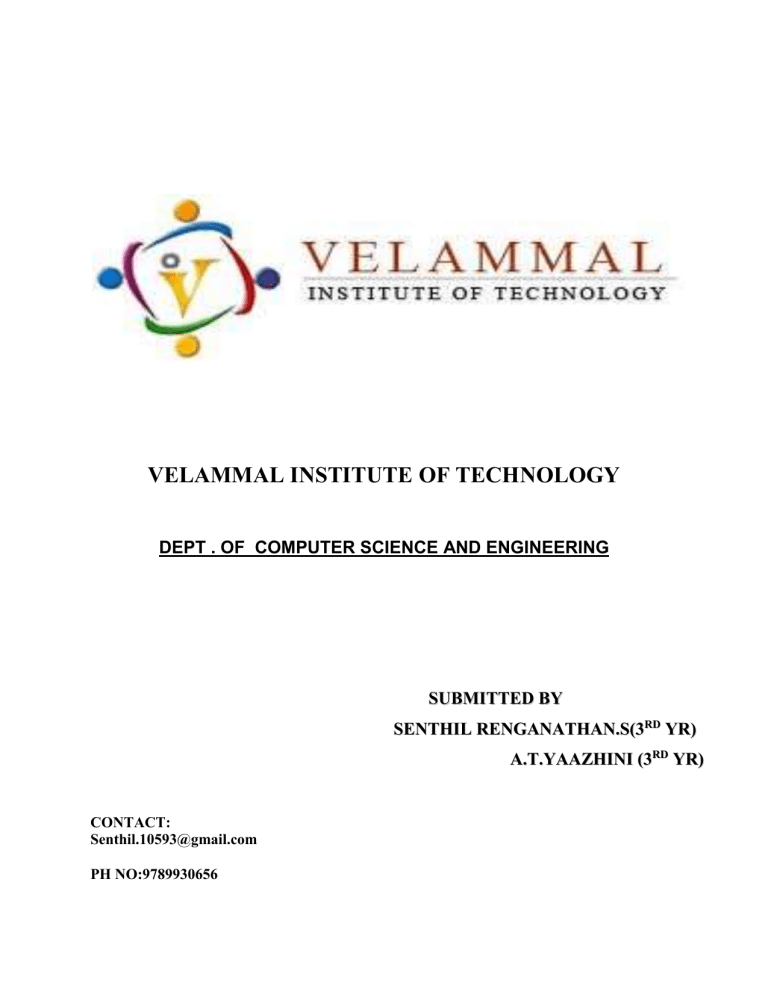
VELAMMAL INSTITUTE OF TECHNOLOGY
DEPT . OF COMPUTER SCIENCE AND ENGINEERING
S U B M I I T T E D B Y
S E N T H I I L R E N G A N A T H A N .
.
S ( ( 3 R D Y R ) )
A .
.
T .
.
Y A A Z H I I N I ( ( 3 R D Y R ) )
CONTACT:
Senthil.10593@gmail.com
PH NO:9789930656
IMPLEMENTING NANO ROBOTS IN
VENTILATION &IN BLOOD SUGAR DETECTION (mobile phones)
ABSTRACT
NANO-BIOTECHNOLOGY is now becoming an emerging field that is going to bring a lot of changes in the current century of technological revolution. It is a one part of
NANO-TECHNOLOGY .Apart from its participation in all fields, the part of nanos in human science and medicine is large.
NANOMEDICINE is the process of diagnosing, treating, preventing disease and traumatic injury, of relieving pain, and of preserving and improving human health, using molecular tools and molecular knowledge of the human body.Most symptoms such as fever and itching have specific biochemical causes that can also be managed, reduced, and eliminated using the appropriate injected nanorobots.
Our paper mainly concentrated on implementing NANO
ROBOTS in detecting human physiology.
This paper mainly concentrates on implementing nano robots in medical field. In this paper we have two ideas:
One is using nano robots to exhale oxygen and carbon di oxide according to the human pressure. The nano robots are called as artificial red cells.
The second part of our paper deals with introducing nanosensors and nanorobots in detecting Human Blood
Sugar Level. These nanorobots are
Embedded With Mobile Phones and the status of the patient can be read from remote places. These nano particles that reduce the size of microelectronic components will become a major part in human medicines, which may make this entire world to hide in a single chip.
APPLICATIONS:
* We could then hold our breath for nearly 4 hours if sitting quietly at the bottom of a swimming pool.
* If we were sprinting at top speed, we could run for at least 15 minutes before we had to take a breath!
INTRODUCTION:
The term
“Nanotechnology” generally refers to engineering and manufacturing at the molecular or nanometer length scale. (A nanometer is one-billionth of a meter, about the width of 6 bonded carbon atoms.) .
Nanotechnology will have given us specially engineered drugs which are nanoscale cancerseeking missiles, a molecular technology that specifically targets just the mutant cancer cells in the human body, and leaves everything else blissfully alone. To do this, these drug molecules will have to be big enough – thousands of atoms – so that we can code the information into them of where they should go and what they should kill. They will be examples of an exquisite, human-made nanotechnology of the future. It is most useful to regard the emerging field of nanomedicine as a set of three mutually overlapping and progressively more powerful technologies.
First, in the relatively near term, nanomedicine can address many important medical problems by using nanoscale-structured materials that can be manufactured today.This includes the interaction of nanostructured materials with biological systems. Second, over the next 5-10 years, biotechnology will make possible even more remarkable advances in molecular medicine and biorobotics (microbiological robots), some of which are already on the drawing boards.Third, in the longer term, perhaps 10-20 years from today, the earliest molecular machine systems and nanorobots may join the medical armamentarium, finally giving physicians the most potent tools imaginable to conquer human disease, illhealth, and suffering.
Our paper concentrates mainly on our dream system that uses nano sensor in mobile phones to detect human blood sugar level and also nano robots in respiratory process. Most broadly, nanomedicine is the process of diagnosing, treating, and preventing disease and traumatic injury, of relieving pain, and of preserving and improving human health, using molecular tools and molecular knowledge of the human body. “Over the past century we have learned about the workings of biological nanomachines to an incredible level of detail, and the benefits of this knowledge are beginning to be felt in medicine. In coming decades we will learn to modify and adapt this machinery to extend the quality and length of life.”
MAKING NANO ROBOTS:
The typical medical nanodevice will probably be a micron-scale robot assembled from nanoscale parts. These parts could range in size from 1-100 nm (1 nm = 10 -9 meter), and might be fitted together to make a working machine measuring perhaps 0.5-3 microns (1 micron = 10 -6 meter) in diameter. Three microns is about the maximum size for blood borne medical nanorobots, due to the capillary passage
requirement. Carbon will likely be the principal element comprising the bulk of medical nanorobots, probably in the form of diamond or diamonded/fullerene nanocomposites largely because of the tremendous strength and chemical inertness of diamond. Many other light elements such as hydrogen, sulfur, oxygen, nitrogen, fluorine, silicon, etc. will be used for special purposes in nanoscale gears and other components.
APPEARANCE OF NANO ROBOTS:
It is impossible to say exactly what a generic nanorobot would look like. Nanorobots intended to travel through the bloodstream to their target will probably be 500-3000 nanometers (1 nanometer = 10-9 meter) in characteristic dimension. Nonblood borne tissue-traversing Nanorobots might be as large as 50-100 microns, and alimentary or bronchial-traveling nanorobots may be even larger still. Each species of medical Nanorobots will be designed to accomplish a specific task, and many shapes and sizes are possible.
In most cases a human patient who is undergoing a nanomedical treatment is going to look just like anyone else who is sick. The typical nanomedical treatment (e.g. to combat a bacterial or viral infection) will consist of an injection of perhaps a few cubic centimeters of micron-sized nanorobots suspended in fluid (probably a water/saline suspension).
The typical therapeutic dose may include up to 1-10 trillion (1 trillion = 10 12 ) individual nanorobots, although in some cases treatment may only require a few million or a few billion individual devices to be injected. Each
Nanorobot will be on the order of perhaps 0.5 micron up to perhaps 3 microns in diameter.
(The exact size depends on the design, and on exactly what the nanorobots are intended to do.) The adult human body has a volume of perhaps 100,000 cm 3 and a blood volume of
~5400 cm 3 , so adding a mere ~3 cm 3 dose of nanorobots is not particularly invasive. The nanorobots are going to be doing exactly what the doctor tells them to do, and nothing more (barring malfunctions). So the only physical change you will see in the patient is that he or she will very rapidly become well again. Most symptoms such as fever and itching have specific biochemical causes which can also be managed, reduced and eliminated using the appropriate injected nanorobots. Major rashes or lesions such as those that occur when you have the measles will take a bit longer to reverse, because in this case the broken skin must also be repaired.
ARTIFICIAL RED CELL:
We named this
Nanrobot as ventilons.The ventilons measures about 1 micron in diameter and just floats
along in the bloodstream. It is a spherical nanorobot made of 18 billion atoms. These atoms are mostly carbon atoms arranged as diamond in a porous lattice structure inside the spherical shell. The ventilons is essentially a tiny pressure tank that can be pumped full of up to 9 billion oxygen (O
2
) and carbon dioxide (CO
2
) molecules. Later on, these gases can be released from the tiny tank in a controlled manner. The gases are stored onboard at pressures up to about 1000 atmospheres. (Ventilons can be rendered completely nonflammable by constructing the device internally of sapphire, a flame proof material with chemical and mechanical properties otherwise similar to diamond.).
The surface of each ventilons is 37% covered with 29,160 molecular sorting rotors that can load and unload gases into the tanks. There are also gas concentration sensors on the outside of each device. When the nanorobot passes through the lung capillaries, O
2
partial pressure is high and CO
2
partial pressure is low, so the onboard computer tells the sorting rotors to load the tanks with oxygen and to dump the CO
2
. When the device later finds itself in the oxygen-starved peripheral tissues, the sensor readings are reversed. That is, CO
2 partial pressure is relatively high and O
2 partial pressure relatively low, so the onboard computer commands the sorting rotors to release O
2
and to absorb CO
2
.
Ventilons mimic the action of the natural hemoglobin-filled red blood cells. But a ventilons can deliver 236 times more oxygen per unit volume than a natural red blood cell.
This nanorobot is far more efficient than biology, mainly because its diamondoid construction permits a much higher operating pressure. (The operating pressure of the natural red blood cell is the equivalent of only about 0.51 atm, of which only about
0.13 atm is deliverable to tissues.) So the injection of a 5 cm 3 dose of 50% ventilons aqueous suspension into the bloodstream can exactly replace the entire O
2
and CO
2 carrying capacity of the patient's entire 5,400 cm 3 of blood. Ventilons will have pressure sensors to receive acoustic signals from the doctor, who will use an ultrasound-like transmitter device to give the ventilons commands to modify their behavior while they are still inside the patient's body. For example, the doctor might order all the ventilons to just stop pumping, and become dormant. Later, the doctor might order them all to turn on again.
ARROW indicates high pressure of 1000 atm.
CIRCLE indicates nano particles.
CARBON-DI-
OXIDE
&
OXYGEN
APPLICATION:
By adding 1 litre of ventilons into our bloodstream, we could then hold our breath for nearly 4 hours if sitting quietly at the bottom of a swimming pool. Or if we were sprinting at top speed, we could run for at least 15 minutes before we had to take a breath! It is clear that very "simple" medical nanodevices can have extremely useful abilities, even when applied in relatively small doses. Other more complex devices will have a broader range of capabilities. Some devices may have mobility the ability to swim through the blood, or crawl through body tissue or along the walls
of arteries. Others will have different shapes, colors, and surface textures, depending on the functions they must perform. They will have different types of robotic manipulators, different sensor arrays and so forth. Each medical nanorobot will be designed to do a particular job extremely well, and will have a unique shape and behavior.
OUR NANOSYSTEM TO DETECT HUMAN
PHYSIOLOGY:
Currently operate with micron sized active regions and offer the ability to do thousands of measurements in individual gene activities. Such arrays will allow hundreds of thousands of human genes to be monitored throughout a mission and will allow the determination of the effects of microgravity on human physiology in ways that are not imagined at present, as well as providing early warning of cancer or other disease states. In many cases, sensors will be integrated with on-chip signal processing and data acquisition along with micro fluidics and other sample transport and preparation technologies. Systems for sensing biological and inorganic substances of interest in both aqueous and gaseous phases are needed. The advantages of a laboratory on a chip include device miniaturization for the space and volume restrictions of space travel, lower power consumption, nearly instantaneous response times for near-real time results, conservation of reagents, and ease of operation by non-laboratory personnel, such as astronauts. As with many advances in nanotechnology, the chief difficulty may be in integrating these many different units into functioning systems and interfacing them to the macro real world.
NANOSENSORSING
MOBILEPHONES:
DISPLAY
NANO SENSORS TO DETECT
PULSE RATE
&
CORPUSCLES
PINS TO INTAKE
BLOOD
MOBILE
COMPONENTS
NANO ROBOTS TO
EXTRACT GLUCOSE CELLS
IN BLOOD
System demonstration:
Our mobile system has small pins attached to the mobile phones.
These pins help in taking samples of glucose.
From these samples the corpuscles are readed using the small specific nanorobots inside the mobile.
Nano-chromatrons separate the glucose molecules which cause diabetes.
The molecules inhibited are read and compared with the other section and the approximation is made about the sugar level.
These sugar levels are compared with compressed DB’s and precautions are displayed.
By having sound sensors it may be possible to calculate heartbeats & pulse rates there by calculating the
BP level.
Nano robots used in our mobile phones
CONCLUSION:
Nanomedicine will eliminate virtually all common diseases of the 20th century, virtually all medical pain and suffering, and allow the extension of human capabilities most especially our mental abilities. Consider that a nanostructured data storage device measuring ~8,000 micron 3 , a cubic volume about the size of a single human liver cell and smaller than a typical neuron, could store an amount of information equivalent to the entire
Library of Congress. If implanted somewhere in the human brain, together with the appropriate interface mechanisms, such a device could allow extremely rapid access to this information.
A Single nanocomputer CPU, also having the volume of just one tiny human cell, could compute at the rate of
10 teraflops (10 13 floating-point operations per second), approximately equaling (by many estimates) the computational output of the entire human brain. Such a nanocomputer might produce only about 0.001 watt of waste heat, as compared to the ~25 watts of waste heat for the biological brain in which the nanocomputer might be embedded.
But perhaps the most important long-term benefit to human society as a whole could be the dawning of a new era of peace. We could hope that people who are independently well-fed, well-clothed, well-housed, smart, welleducated, healthy and happy will have little motivation to make war. Human beings who have a reasonable prospect of living many "normal" lifetimes will learn patience from experience, and will be extremely unlikely to risk those "many lifetimes" for any but the most compelling of reasons.
